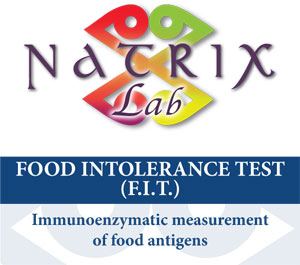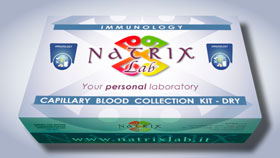What is it and what is it used for?
The Food Intolerance Test (F.I.T.) is performed using the ELISA method to identify the food protein that the organism reacts adversely to, available in the test for 46, 92 and 184 foods.
List of tested foods in: FIT 46 FIT 92 FIT 184
Our everyday foods that we love and seem harmless, can hide substances that our body has developed food intolerances to: they are dose dependent reactions (proportional to the amount of the food eaten), whose symptoms are related to the build-up of substances our organism cannot tolerate, and which appear after a certain time since the food was eaten, which makes it difficult to automatically correlate cause and effect.
Are you vegetarian? We have news for you!

FIT Milk Egg Vegetarian
A vegetarian is a person who does not eat animals, birds and fish or products that contain them.
Vegetarian diet models can vary considerably.
The milk-egg-vegetarian model that is analysed in this profile, available in the test for 92 foods, is based on cereals, vegetables, fruit, pulses, seeds, nuts, dairy products and eggs.
List of tested foods: FIT 92 MEV
Who should take the test?

The Food Intolerance Test is recommended generally to anyone who wants to begin a more correct diet, i.e. considering any foods that are not tolerated, or alternatively for anyone before undergoing analyses or invasive instrumental examinations, if you have one or more of these symptoms:
- General symptoms: tiredness, fluid retention, bags under the eyes, postprandial sleepiness, halitosis, increased sweating.
- Nervous system: headache, anxiety, depression, irritability, lack of memory, difficulty in concentration, dizziness.
- Respiratory tract: hard to breath, asthma, cough, allergic rhinitis, sinusitis.
- Cardiocirculatory tract: change in blood pressure, palpitations, extrasystolic.
- Gastro-intestinal tract: bloated sensation, nausea, abdominal pain and cramp, alveoli disorders (diarrhoea, constipation), aerophagy.
- Urogenital apparatus: cystitis, urogenital inflammation, premenstrual syndrome.
- Muscle-skeletal apparatus: cramp, muscle tremors, weak muscles, joint pain, muscle-tendon inflammation.
- Epidermis: local and general itching, acne, eczema, dermatitis.
How and where to take the test?
The test involves analysing a blood sample, and can be requested in analysis laboratories, medical centres, health spas and pharmacies that offer NatrixLab diagnosis services.
Preparing for the test: there is no need to fast beforehand, the sample can be taken at any time of the day.
…and afterwards?

If the test discovers food intolerances, a food protocol should be adopted to recover tolerance in order to eliminate the foods that are not tolerated and then gradually reintroduce them.
Beware of homemade diets: eliminating something from your diet should not be taken lightly because, for example, if you exclude the protein that you are intolerant to, you are also depriving yourself of the other nutrients that food contains, which you have to then find elsewhere.
In more than ten years’ experience in food intolerance diagnosis, NatrixLab has perfected food protocols to recover tolerance. Please contact us for explanations about your test and how to organize a specific food protocol.
Repeating the test
We recommend repeating the test after 6-8 months, to monitor the state of your general health and see whether the diet to recover tolerance has solved the problems that were found in your previous test.
Related tests
Related tests
Celiac Test

The Celiac Test is an allergy test with highly sensitive and specific results to identify positivity for celiac disease.
Find out more
Gluten Sensitivity Test

The Gluten Sensitivity Test determines whether there are gluten sensitivity markers to measure non-celiac gluten intolerance.
Find out more
In Flora Scan

“In Flora Scan” is a complete test that is useful to evaluate the flora, any inflammation in the intestine, digestive capacity and intestinal permeability.
Find out more
Bibliography
- Atkinson W, Sheldon TA, Shaart N, Whorwell PJ. Food elimination based on IgG antibodies in irritable bowel syndrome: a randomised controlled trial, Gut. 2004; 53(10): 1459-1464.
- Ou-Yang WX, you JY, Duan BP, Chen CB. Application of food allergens specific IgG antibody detection in chronic diarrhea in children. Zhongguo Dang Dai Er Ke za Zhi. 2008; 10(1): 21-24.
- Vance GH, Thornton CA, Bryant TN, Warner JA, Worner JO. Ovalbumin-specific IgG and subclass response through the first 5 years in relation to duration of egg sensitization and the development of asthma. Clinical experimental Allergy. 2004; 34: 1542-1549.
- Zuo XL, Li YQ, LiWJ, Guo YT, Lu XF, Li JM, Desmond PV. Alteration of food allergen-spegific serum immunoglobulins G and E antibodies in patients with irritable bowel syndrome and functional dyspepsia. Clin. Exp. Allergy. 2007; 37(6): 823-830.
- Wilders-Truschnig M, Mangge H, Lieners C, Gruber H, Mayer C, März W. IgG antibodies against food antigens are correlated with inflammation and intima media thickness in obese juveniles. Exp. Clin. Endocrinol. Diabetes. 2008; 116(4): 241-245.
 NatrixLab Laboratorio di analisi – nutrizionista
NatrixLab Laboratorio di analisi – nutrizionista

